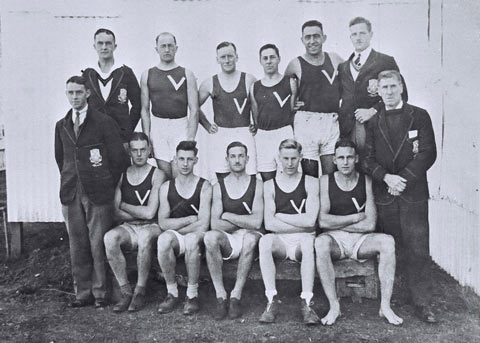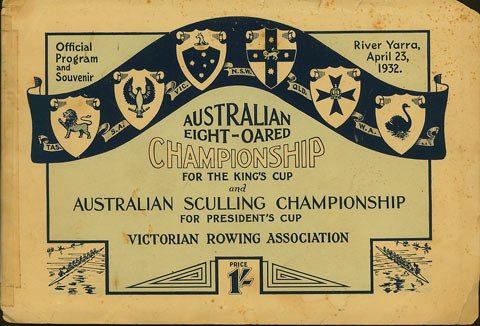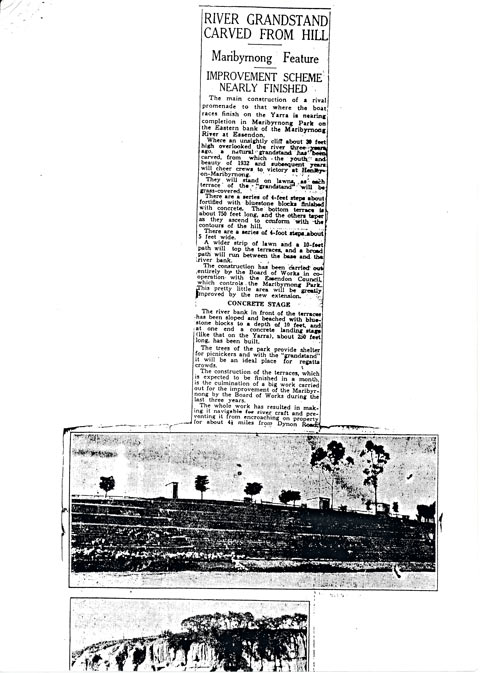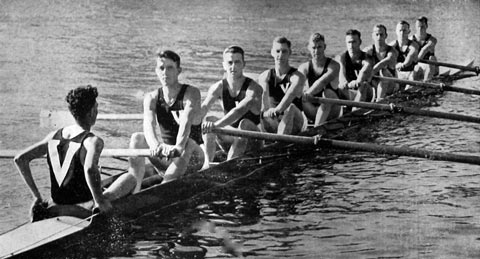History of Essendon Rowing Club, 1880-1980
Table of Contents
Chapters
- The Origins of the Sport
- The Development of the Sport
- The Founding of the Club - 1880-89
- Inter-club Competition - 1890-99
- Federation and Senior Success - 1900-09
- The War Years - 1910-19
- Recovery from the War - 1920-29
- Jubilee Year and Beyond - 1930-39
- Another War, Another Recovery - 1940-49
- Junior Sucess Again - 1950-59
- Senior Rise to the Top - 1960-69
- The New Clubhouse - 1970-79
Appendices
8. Jubilee Year and Beyond - 1930-1939
Jubilee year of the Club began on November 9th when A.S. Drakeford M.L.A. opened the afternoons festivities with an interesting address on rowing generally and the history and achievements of the E.R.C. in particular. The new Honour Board was unveiled by Mrs. Fenton the wife of the Mayor. Socials and Euchre tournaments were successful during the off season helping the finances of the Club.
Mr. T.L. Mannix was elected as manager of the Victorian crew contesting the King's Cup in South Australia on May 3rd 1930. Also this year he continued to be the Honorary Secretary of the Victorian Rowing Association.

1930 Victorious Victorian team
During this 1929-30 season the Clubhouse was insured for £3,000, a bicycle was purchased for the use of the coaches, the committee decided that Life Membership should be granted to only one candidate every ten years and then only to those of ten or more years membership.
The Mayor of Essendon became the third trustee of the Club and the date of the Annual General Meeting was changed to May.
The Annual Smoke Night was “…dispensed with on account of the financial position of the Club…"and as the annual subscriptions fell the prospect for the new season were diminished although the clubs assets were considerable.
The profits from the popular bi-weekly dances held at the Town Hall were falling especially after the new amusement tax was deducted from the proceeds. With the purchase of a racing clinker eight, a clinker racing four and a set of swivel riggers for the practise eight, club finances were depressed.
Club races were reduced to five. A Blink Appeal Fours was held, the Club points trophy was donated by the retiring committee. There were several challenge races between Footscray and Essendon -- Footscray won on all occasions.
The Club membership consisted of eight Life Members and 88 active rowers. In an endeavour to increase income from subscriptions by at least £50.0.0 per annum, an organised campaign was instigated to encourage young men to enrol in the Club, this resulted in eight new financial members. The social event of the season was the Jubilee Smoke Night - members past and present were invited. The attendance was over 300 and these included members from the Victorian crew who won both the King's Cup at Mannum in South Australia and the Interstate Eight Oared Championship of Australia.
A design by Miss O'Donnell was accepted as the Club pocket emblem for blazers.
The original staging had to be replaced after the M.&M.B.W. had removed it for river improvement work. The new staging was made of red gum and the outer edge built 6 inches below the water level.
Mrs. Muir performed the christening of the new clinker four, the "N.S. Muir" after her husband.
The first Bi-annual General Meeting was held on December 4th 1930, this was accepted as club policy until 1936.
Essendon found the 1931-32 season difficult, although they closely contested the maiden events they were unable to secure a win. Junior crews won the pairs and fours at the Upper Yarra, Footscray and Barwon Regattas.
The Australian Rowing Championships were held on the Yarra and Victoria retained the King's Cup. T.L. Mannix was the manager and secretary for this crew.

The social and library committees were active and financial throughout the season but these were insufficient to put the Club on it's feet. With the formation of a Maintenance Committee under Ron Keilar, the responsibility of the boats fell to them and eased the burden on the finances of the Club. Club rowing continued although the expenditure on trophies caused more financial embarrassment. The long discussed "Cock of the Walk" fours took place. The perpetual trophy was donated by J.A. McFarlane. This competition was a series of Challenge races to be rowed in light-weight four oared practise boats. The race was to be contested over half a mile by crews chosen and graded by the Club selectors. The cost per entry was 2/- per challenge; to be paid a week prior to the race; and the challenged crew had to race within 14 days of the issue of the challenge or forfeit. The first victorious crew to the “J.A. McFarlane Shield" comprised of Lillicrap (Bow) 2. J. Fleming, 3. C. Maclintosh and Stroke L. Fosdick, who withstood four challenges.
Additional victories for the club came about when Essendon won the Benwell Pairs at Henley on the Maribyrnong.
Club membership had dropped to 76 so the Committee decided to encourage public awareness of rowing and consequently offered scholarships to eight Essendon High School students in an endeavour to select a crew to represent the school at the following Henley on the Yarra. These scholarships were awarded to Murphy, Smith, Bennett, Stewart, Carvell, Findlay, Bennett and Baxter. They were eliminated in their heat by the ultimate winners.
On October 1931 members Morris, Keilar and Mannix were asked to induce “…12 military trainees of good physiques to join the Club with a view to special coaching for the United Services Regatta in 1932.”

The 1932 river improvements
Physical Culture classes were introduced to promote and maintain fitness over the Winter months; this Class was conducted concurrently with a skipping competition. G. Corkhill from the Victorian Railways Institute conducted both and donated the trophy for the competition which was won by Jack O'Neil.
It was decided on March 10th, 1933 to donate the craft "Alert" to the Essendon Canoe Club, and to accept the subcontractors quote of £25.0.0 to paint the exterior of the Clubhouse.
The Social Committee decided to conduct fortnightly dances in the Moonee Ponds Town Hall from February to November and a function was held in the Clubhouse on the alternative Saturdays - both continued whilst they were financially viable. The Clubhouse festivities were stopped in August 1933 on orders from the Board of Health.
Season 1932-33 proved to be very successful competitively and financially. Essendon won the Junior Premiership of Victoria with 44 points and the Social Committee raised about £400.0.0. The Junior racing eight crews scored a number of double victories - at the Upper Yarra and Footscray regattas. The Junior crew which won at Barwon and Ballarat represented the Club in the Senior Eight Oared Championship of Victoria.
“..The crew put up a very meritorious performance in running fourth out of seven…”
The Committee realising that hard times were ahead, decided on October 6th, 1932, to open a bank account - the 'Essendon Rowing Club Replacement Account' as an insurance for future boat replacements, and at each regular meeting a sum of money was to be allocated from the General Funds into this account.
Mr. Bob Grey conducted a Pleasant Sunday Afternoon at the Clubhouse on April 30th 1933. This first afternoon was organised to raise money to aid the Mayor's Appeal. In following years, this afternoon was held later on in the year and funds raised were for club use.
The race of the 1933-34 season was the victory in the Champion Junior Eight race. This was the first time an Essendon crew had won this race since it's induction. The Challenge four crew gained victory at the Preston Regatta when they came home with the J.V. Gunst Cup – the third win - which entitled the Essendon Rowing Club to retain the Cup.
Financially the Club was sound and had the resources to order two new practise fours. At the Opening Day on October 14th 1933, Mrs. Birkenhead had the honour of christening these craft the "W.G.H. Birkenhead" and the "N.S. Muir". The clinker four the "F .E. Parr" was renamed the "J. Nicholaisen” on this day too.
Membership was declining and consequently so to was income from subscriptions. The· attendance at the fortnightly dances was fluctuating so a special meeting was called to try and solve these problems and increase membership. An Evening Dress evening was held in the New Year from 9.00 p.m. to 1.00 a.m. at 6/-per double. The annual ‘Learn to Row’ month was conducted in February. A trophy was awarded to the member who introduced the greatest number of new members to the Club. Subscriptions again were raised at the A.G.M.
The financial Library Committee presented a cup case to the Club during July, and purchased chairs for the Clubrooms, defrayed a portion of expenses of the Annual Smoke Night and entertained the members after the Footscray Regatta.
Successes for the club was gained with victory in the Lightweight Pair at the Novice Regatta on September 1st 1934. Early 1935 at Henley on the Maribyrnong the pair consisting of A.C. Evans (bow), E.K.L. Varcie (Stroke) and O. Copas (Cox) won the Challenge Pair race for the third time and made the Benwell Cup property of the Essendon Rowing Club.
A special General Meeting was called in January 1935 to discuss how £130.0.0 could be raised to liquidate the Club's liabilities. A ladies committee was formed, led by Misses Truman, Swanson and Mrs Halse, who organized a combined dance held on March 30th which realized a profit of £96.0.0 and ran a series of Euchre nights throughout the season.
The Essendon City Council had drains laid alongside the Clubhouse to aid drainage away from the foundations. The Club's committee had urged for immediate attention lo be taken after the Hawthorn Clubhouse and boats were swept away by floods in December 1934.
T.L. Mannix was elected to the executive of the V.R.A. this year.
The Library Committee donated £20.0.0 towards the proposed Building Extension Fund.
A wireless was purchased for the Clubhouse after members had contributed 3 pence per week over the season.
Two regatta wins were recorded for 1935-36 - they were Maiden Eight victories at Footscray and Upper Yarra. A clinker four was lent to the Victorian crew contesting in the Australian Championship. La Roche was elected as a Life Member and was selected to coach the Victorian Inter State eight oar crew.

Victorian Eight coached by H LaRoche
The club organized three club races for the season.
The Euchre nights were discontinued during November proving to be unfinancial.
Membership was down to 54 - 40 of these were active rowers. The Committee decided to advertise for new members on November 7th and did so through the press and picture screens but this proved to be an unsuccessful venture.
The Tom Morrison Memorial Honour Board was presented to the Club by the Morrison family in memory of Tom who had been an E.R.C. member for ten years prior to a fatal motor accident. This board, which had sufficient space for 20 names, was to record the Best Clubman of the season; R.K.T. Graham gained this first award.
The Club had an outstanding overdraft of £60.0.0 and it was decided at a special meeting that the committee should divide into three groups and each had the responsibility of raising £20.0.0 - it was a good idea! The Constitution was revised at the Annual General Meeting because attendance there failed to meet the quorum. The number for a quorum was changed from 9 to 5 and the committee was altered to 7 - 3 e1ected Vice Presidents and five in the committee. The Club appointed A. E. Gideon as Honorary J.P.
There was a door charge of 2/6 at the Annual Smoke Night.
1936-7 was a slow year, the only inter club success was achieved by R.H. Tucker's sculling at the Novice Regatta in November. The Club ran two races -The President's Fours in October and the .J.R. Brown Pairs in April 1937. Due to the decline in membership there were only 18 oarsmen available for selection. W. Lavers offered a trophy for the oarsmen who rowed the greatest number of occasions - this was won by George Wilkins.
Rowing during the next season proved little better. Membership dwindled and there were only nine oarsmen to represent the club at the various regattas during 1937-38. One maiden four competed six times but were unsuccessful each time. One lightweight four competed twice and sculls entered at Ballarat.
The President, A.E. Gideon resigned and this office was vacant until October when it was accepted by N.S. Muir.
It was decided to combine all bank accounts thereby overcoming the overdraft in one by the others. A trophy of a year's free subscription was offered to the member who introduced the greatest number, over three, members before March. This trophy was never won!
An effort was made to revitalise the social activities of the Club and on October 9th Ern Edney organised a Cabaret Ball at Edenhope. The additional funds were necessary to meet the cost of £67.7.0 for repairs and painting of the Clubhouse.
The Club held a dinner at the Lincolnshire Arms instead of their Annual Smoke Night, the expense was covered by those in attendance. The social aspects of the Club improved throughout the season. Arch Shaw donated two trophies at £2.2.0; one to the member who introduced the most new 'recruits', this was carried into the next season as six members had each brought two new members; the other trophy was for a Club Novice Four race.
Again there was only two club races - the Opening Day Fours and the J.R. Brown Pairs. The only inter club success was attained by Ray Tucker who won a double at Ballarat on March 4th 1939 when he won the Maiden and Junior sculls. Additional competition was organised within the Club – four oared and pair oared races were conducted on succeeding Sundays. The entrance fee was 1/-per oar and one point was scored by winning a heat or semi-final and two points for a final. The four leaders received trophies by Mr. Dunly.
